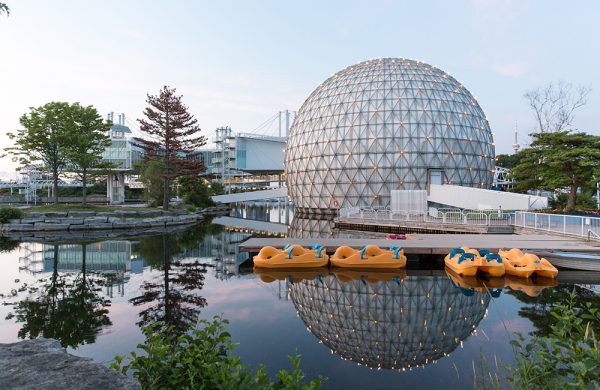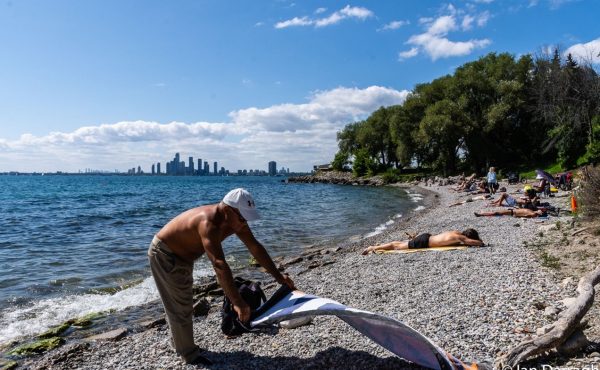
When Sidewalk Labs rolled into Toronto in 2017, there was no ambiguity about the corporate family tree. Sidewalk officials repeatedly said the smart city start-up venture was a kind of mash-up: Google/Alphabet’s money and some of its tech people in a shotgun marriage with an assortment of New York planners, real estate types, lobbyists and alumni of former mayor Michael Bloomberg’s administration. On this point, at least, they were transparent.
Therme Canada, the latest deep-pocketed firm with designs on a chunk of Toronto’s waterfront, is a far more opaque organization, privately held, with no publicly disclosed source of financing besides the entry fees and ancillary revenues generated by its spas.
Even as the second round of public consultations about the firm’s plans for Ontario Place’s West Island gets underway, most Torontonians know only a few details about Therme: that it’s Austrian, privately-held, and owns four spas in Europe, all of them located on large sites on the outskirts of cities like Bucharest. It describes itself as a “global well-being leader” and is planning to significantly expand, opening other spas in the U.K., northern Europe and the U.S.
The Ontario government’s consultation website has no information about either Therme or Live Nation, which seems like an oversight, as they were the successful proponents of a nine-digit RFP that will utterly remake one of the city’s preeminent parks.
The company, however, has deep local connections, overseen by executives who have worked in the office of Premier Doug Ford as well as lobbyists such as StrategyCorp’s John Perenack and Leslie Noble, and Amir Remtulla, Ford’s former EA from his days at City Hall. Its local architect is Diamond Schmitt, whose renderings have stirred controversy since they were made public in the summer. The estimated cost of the spa is $350 million.
So what, exactly, is Therme?
The company traces its roots to an Austrian architect and civil engineer named Josef Wund, who was, according to the accounts I found, pre-occupied with the therapeutic benefits of swimming. Wund, born in 1938, worked on large industrial projects, but began building spas in the 1990s, ultimately opening three, at a cost of €117 million. In central Europe, there’s a long tradition of spas and thermal baths in scenic retreats like Baden.
“In order to secure his remarkable life’s work in the long term, to express his gratitude to people who trust him and to do even more justice to the social responsibility he has always lived in an exemplary manner, Josef Wund founded the Josef Wund Foundation GmbH in agreement with his family,” according to a testimonial on the Foundation’s website.
This description elides a few important details: In 2011, he had to appear in a Stuttgart court to face charges of bribery; news reports indicate the charges were dropped in exchange for a large charitable donation. The Wund Foundation was established four years later and has its offices in Stuttgart, where it supports charities working in the arts, education and health.
In 2017, Wund died in a plane crash, and the company was acquired by a Vienna-based industrial conglomerate called A-Heat Allied Heat Exchange AG, whose subsidiaries include not just the Therme Group, but also firms that make heat exchangers for sectors such as food and chemical processing, air conditioners, and refrigeration systems for trains, etc.
Therme itself has an engineering consulting division called Delta X, which has been operating in Stuttgart for 30 years and works in a wide range of sectors, from automotive to plant construction. All of these firms are privately held, but the corporate family tree suggests that Therme was a strategic acquisition for a larger company with a vertically integrated structure.
Therme’s C-suite includes executives with finance experience, and its U.S. division is headed by John Alschuler, founder of HR&A Advisors, a well-connected New York consultancy that’s provided real estate and economic development advice for Waterfront Toronto. Therme USA’s first project is in New York, a US$300-$350 million wellness spa, location to be determined. The company tapped High Line co-founder Robert Hammond to build it.
There’s no public information I could find to indicate the source of the financing that is underwriting the company’s latest efforts to expand its footprint, although a pair of U.K. spa projects, in Manchester and Glasgow, offer some hints.
In 2020, Therme announced it would be proceeding on a US$325 million spa in Manchester, to be located in an industrial suburb near two large highways. Planned as a 700,000 sq.-ft space, the facility will occupy an 11 ha (28 acres) site, and is scheduled to open next year. In that case, Therme’s real estate partner is Peel L&P, a large British property developer that specialized in brownfield sites and has a £2.4 billion portfolio.
Peel is also the developer of Therme’s Glasgow project, which will be situated on a former industrial canal site and is being bundled with a hotel, and condos. The project includes a low carbon heat network designed to provide energy to 1,100 apartments as well as the spa itself. The Scottish government last summer announced it would be picking up part of the cost of the network.
So far, the Ontario government hasn’t indicated whether its revitalization plans for Ontario Place will include a development partner beyond Infrastructure Ontario itself.
The grant for the low-carbon heating project is by no means a one-off. To smooth its arrival into new markets, Therme has been active in positioning itself as a good corporate citizen — a tactic that will be familiar to anyone who watched Sidewalk’s arrival five years ago.
In Manchester, for instance, the company sponsored a large marathon run, a deal that included naming rights. It donated money to the British Council so it could be the platinum backer for the country’s exhibition at the Venice Biennale.
Art, in fact, is one of the leitmotifs in Therme’s overlapping approach to business and philanthropy. The company has a Berlin-based division called Therme Art, which describes itself as a “cultural incubator” and supports or commissions artists, architects and their projects. Therme has also published “green papers,” for example on its philosophy of “human cities,” presumably as a way of dressing up its presence in the wellness industry.
When Ford unveiled Therme as one of the winning firms for the Ontario Place revitalization last year, the company took care to tout its social and cultural philanthropy as an example of how it advances its mission. The local recipients of its corporate munificence include a deftly curated collection of organizations: the Mississaugas of the New Credit First Nation, Swim Drink Fish (formerly the Lake Ontario Waterkeepers), the Black North Initiative, and the Toronto International Film Festival (TIFF), with whom the company has forged a ten-year partnership called the “Cinematic Cities Initiative.”
TIFF’s website prominently features a lyrical quote from Therme’s Human Cities green paper. “Art is central to being human,” the passage. reads “It speaks to us of the past and the future, of loss and possibility, of suffering and hope. It suggests the existence of meaning outside of ourselves, of spiritual connection, of something more.”
Like, perhaps, a relaxing and pampered afternoon at the spa.





10 comments
What does it mean that Swim Drink Fish, a charity that claims to working for the public, connecting people to water, blah blah blah, has aligned themselves unwaveringly with this? How was this org elected to represent the public, because they clearly don’t, despite what their leader is claiming. They consulted no one. Mark Mattson has doubled down that this is the only solution on their social media, sold people out, just to get some scrappy beach in one tiny section at the cost of the whole park being public? What the actual F? It’s the antithesis of public consultation, cutting people out of the process, creating less accessibility to the lake when it’s already so hard to get to free green and blue space in this city. Again it’s the rich adn powerful that win, and locals with less opportunities loose. A super funded white charity run by some out of touch old guy has no business in this decision. Probably getting paid heavily in some way by Therme to smooth this over and make the public be okay with this. Disgusting and very disheartening. Not helping my climate anxiety to see this kind of move in the water charity sector.
Ultimately, there is only one question that needs to be answered: Will there be a monorail?
If Ogdenville gets one first, then we will all look like chumps…
Matisse is right on! Swim Drink Fish was part of Ontario Place for All, promoting access for all and demanding consultation on the future of Ontario Place, until it wasn’t. We learned it wasn’t with OP4A any more when the Province made the Therme announcement in July 2021. There was Swim Drink Fish at the presser singing the praises of Therme. I see from the SDF promotional material that ThermeCanada is now one of their sponsors. Very disappointed in SDF.
Excellent article. It has changed my mind from “very mildly for” to “against”.
you mention the existence of completed projects by this group elsewhere – including in UK along canals and other waterfront properties. But you report nothing about local responses, what issues or disputes were raised (or resolved)
in those communities – if any?
TIFF? Swim Drink Fish? I’m so grossed out.
Look at how much money Therme is giving Swim Drink Fish to be their mouth piece –
https://www.swimdrinkfish.ca/blog/swim-drink-fish-artists-for-water-art-auction-a-big-success-397zy
This park needs to remain free and public. Full stop. We need people to be the voice, and they are clearly saying what they want and need. Not these folks. These orgs have just shown their hand. And it ain’t got nothing to do with being there for the people. They have no problem taking money from Therme for their orgs to okay a decision that doesn’t impact them. Not everyone has their own beach front properties like Mark Mattson keeps flashing all over his twitter. So greedy. Hope this was worth your reputation.
Also, what is up with the Mississaugas of the New Credit? Really? You’re just super cool with this?
https://toronto.ctvnews.ca/new-spa-village-near-toronto-temporarily-closes-its-pools-after-staph-contamination-1.6117743 Enough said…
sigh…
i’m w/Chrishon & others on this – very disturbing to see Arts [TIFF], Environmental [SDF], Indigenous [Mississaugas of the New Credit First Nation] organizations turning their backs, closing their eyes, abdicating their responsibilities in preventing this heinous re-do of OP from moving forward. please sign these petitions: https://www.change.org/p/save-teachbeach-toronto-s-cleanest-beach/u/31040327, https://savethebeach.ca/, https://www.facebook.com/sharer.php?s=100&u=https%3A%2F%2Fwww.progresstoronto.ca%2Four-city&mc_cid=83c479ffdb&mc_eid=668eea6c0e
Is Lake Ontario Waterkeeper the same as Swim Drink Fish? Lake Ontario Waterkeeper just keeps posting the same article that Swim Drink Fish wrote to justify this whenever anyone calls them out or asks a question. Irony alert: “Transparency matters” is a big theme in this meandering piece.
https://twitter.com/LOWaterkeeper/status/1570090759495491585
Can I commission a “Who’s behind Swim Drink Fish” next because I don’t understand why they have fifty names.
“Peel is also the developer of Therme’s Glasgow project, which will be situated on a former industrial canal site and is being bundled with a hotel, and condos. The project includes a low carbon heat network designed to provide energy to 1,100 apartments as well as the spa itself. The Scottish government last summer announced it would be picking up part of the cost of the network.”
Are we the taxpayers paying for any of this monstrosity?